Abstract
The gastric cholecystokinin-B/gastrin receptor (CCK-BR) is a key regulator of enterochromaffin-like cell function and proliferation. Over the last decade, a number of small non-peptide CCK-BR "antagonists" have been discovered. Here, we demonstrate that some of these non-peptide ligands in fact possess significant ability to activate the human CCK-BR, and are, therefore, more properly categorized as partial agonists. When tested in COS-7 cells transiently expressing the recombinant human CCK-BR, saturating concentrations of the small "peptoid" ligands PD 135,158 and PD 136,450 stimulated inositol phosphate formation to 23 and 43 percent, respectively, of the maximum response induced by a considerably larger endogenous peptide agonist, cholecystokinin octapeptide. In contrast, the benzodiazepine-derived CCK-BR ligand, YM022, acted as a "true" high-affinity antagonist of cholecystokinin-induced inositol phosphate formation (pA2 = 9.69). Consistent with recent findings in animal experiments, our data reveal that small synthetic ligands have the potential to function as either CCK-BR agonists or antagonists. These dual properties of synthetic molecules must be considered when evaluating candidate drugs for human disease.
Full text
PDF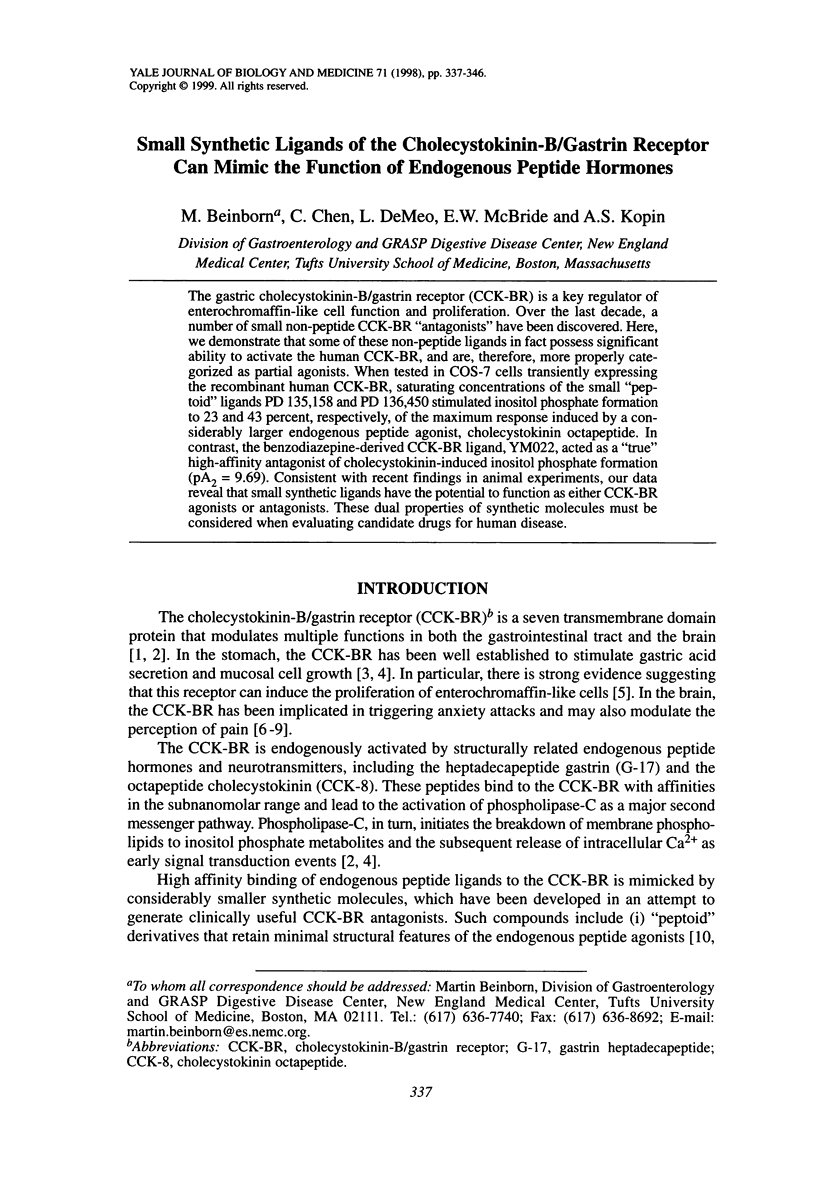

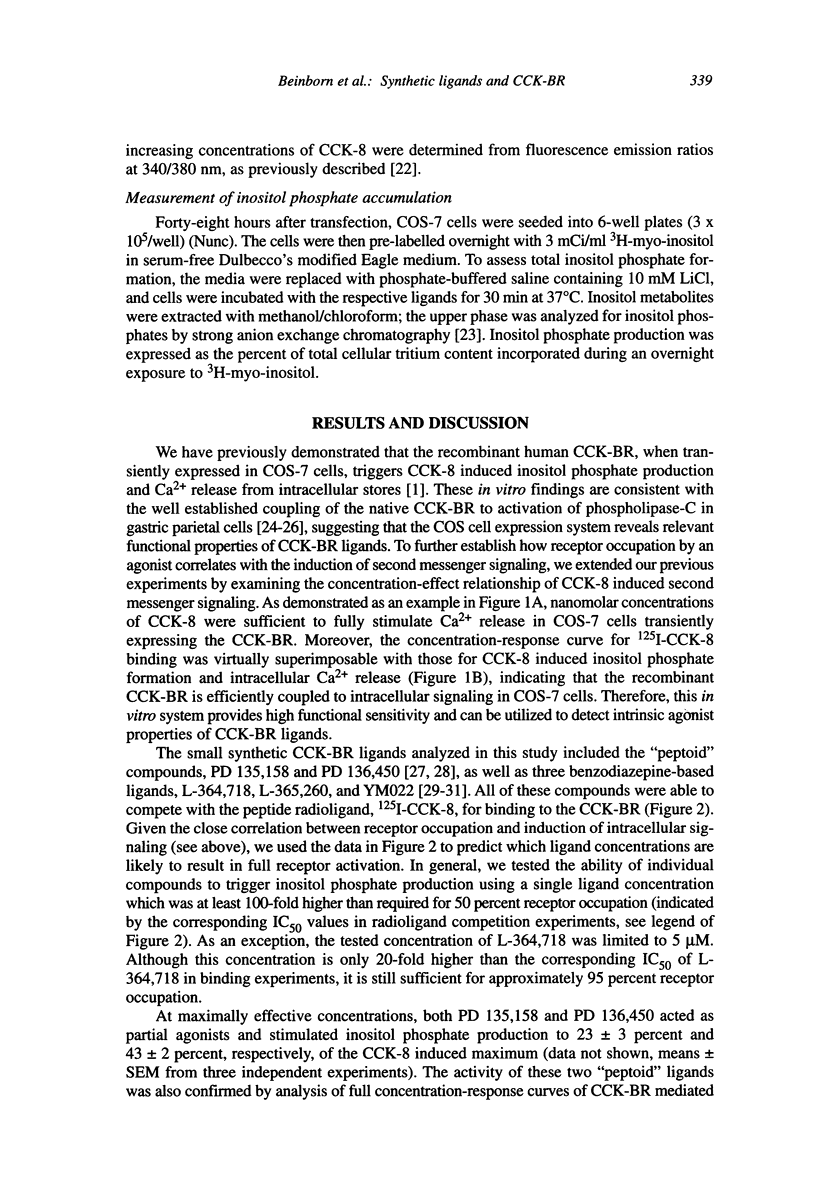
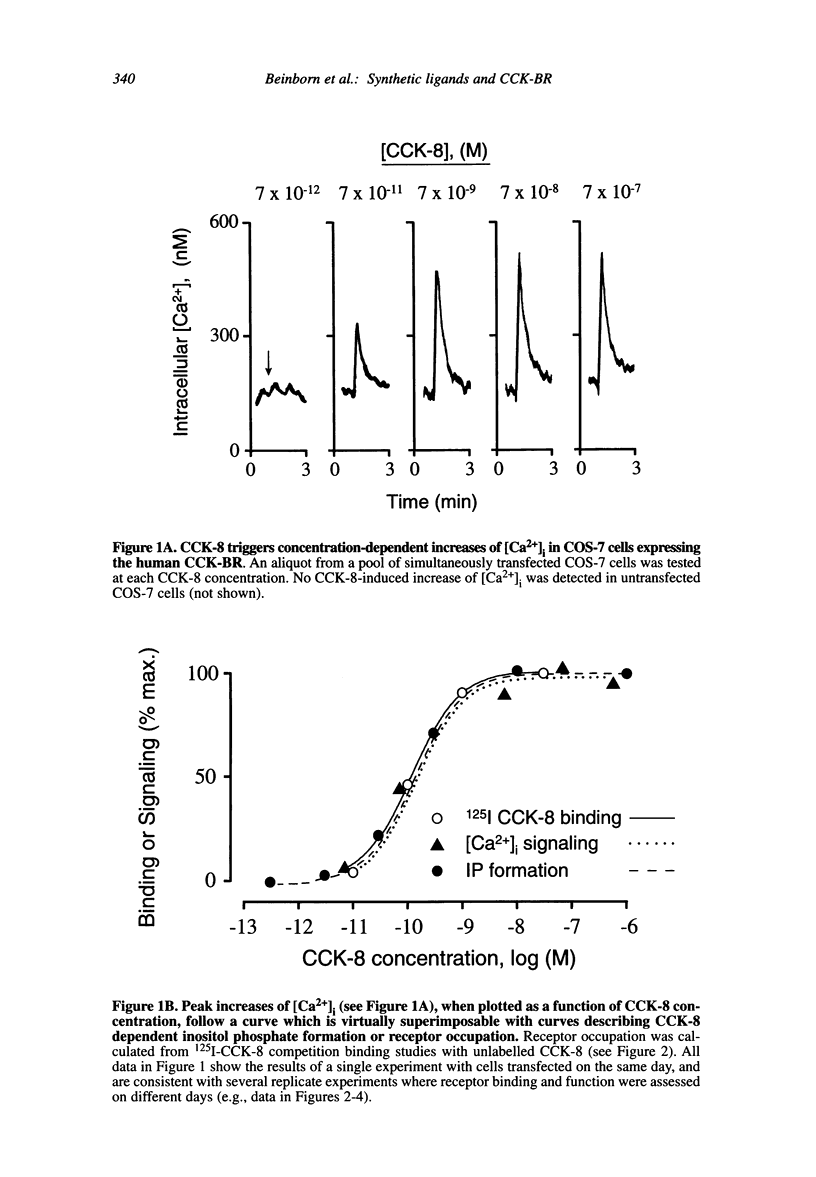

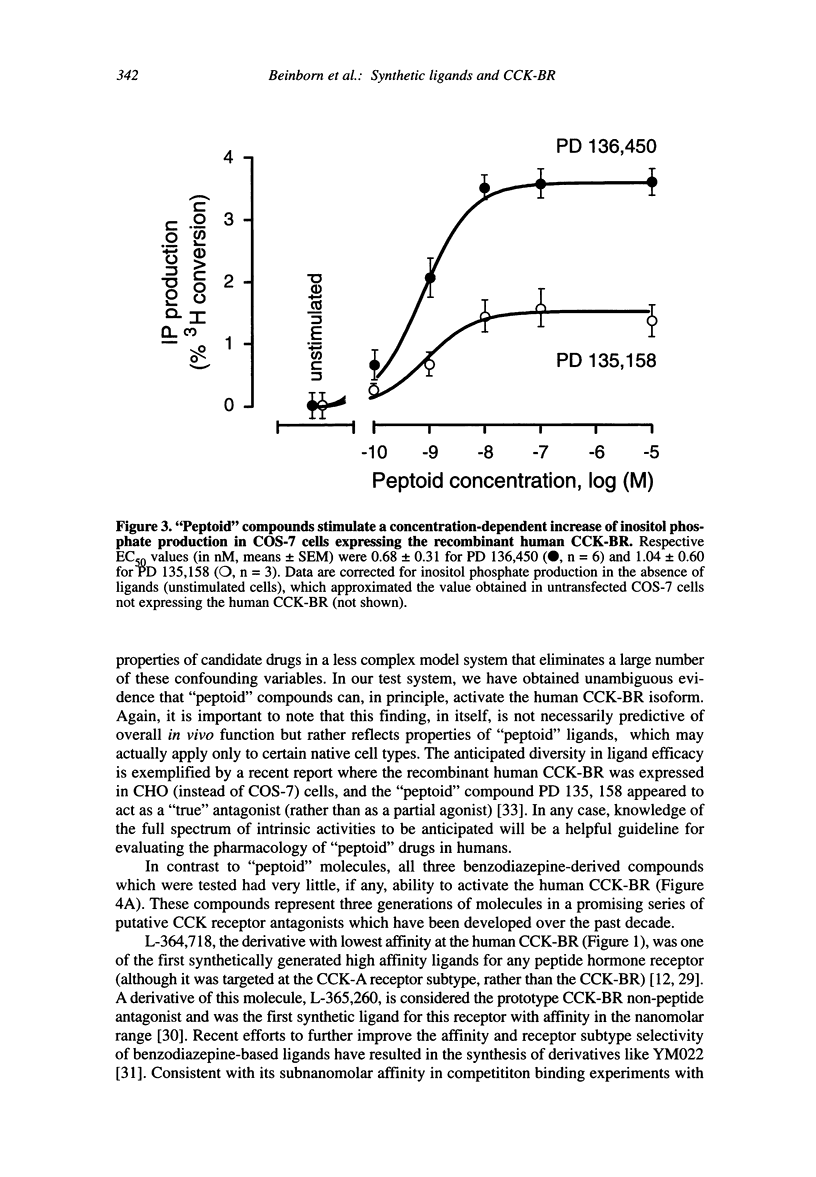
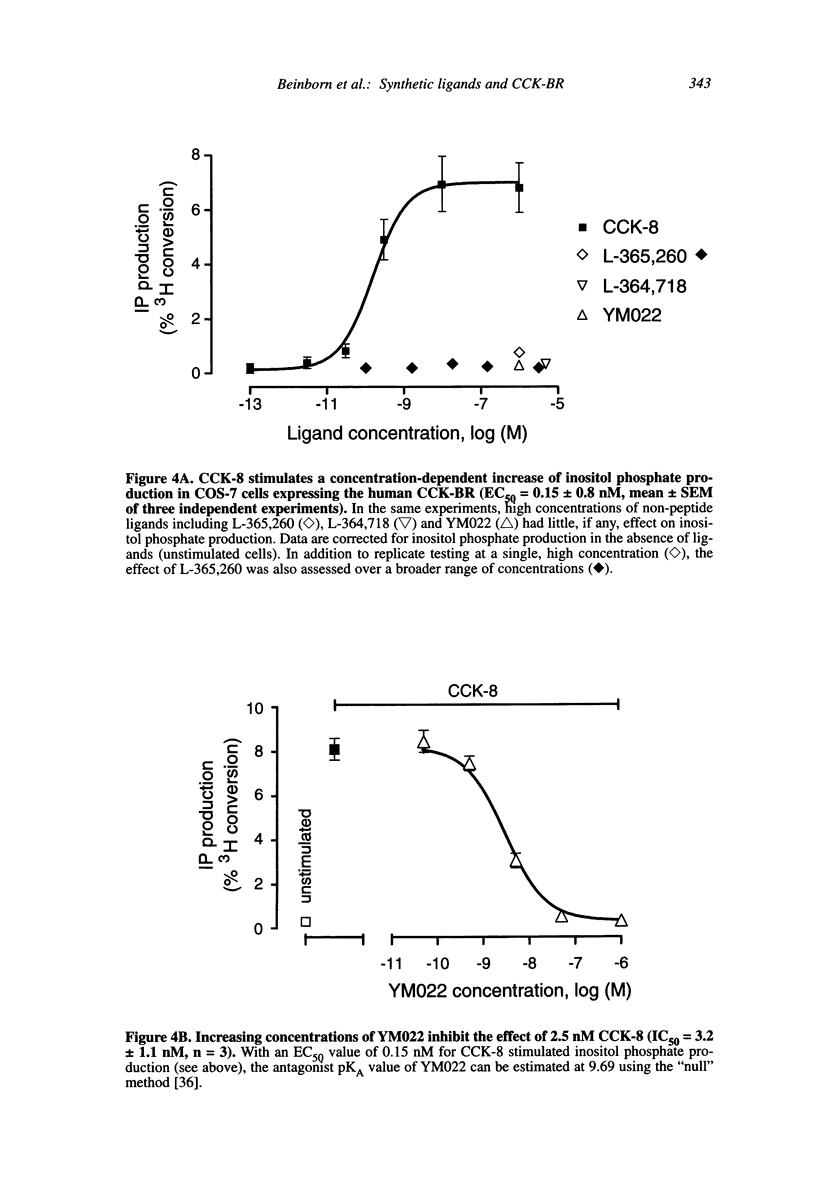
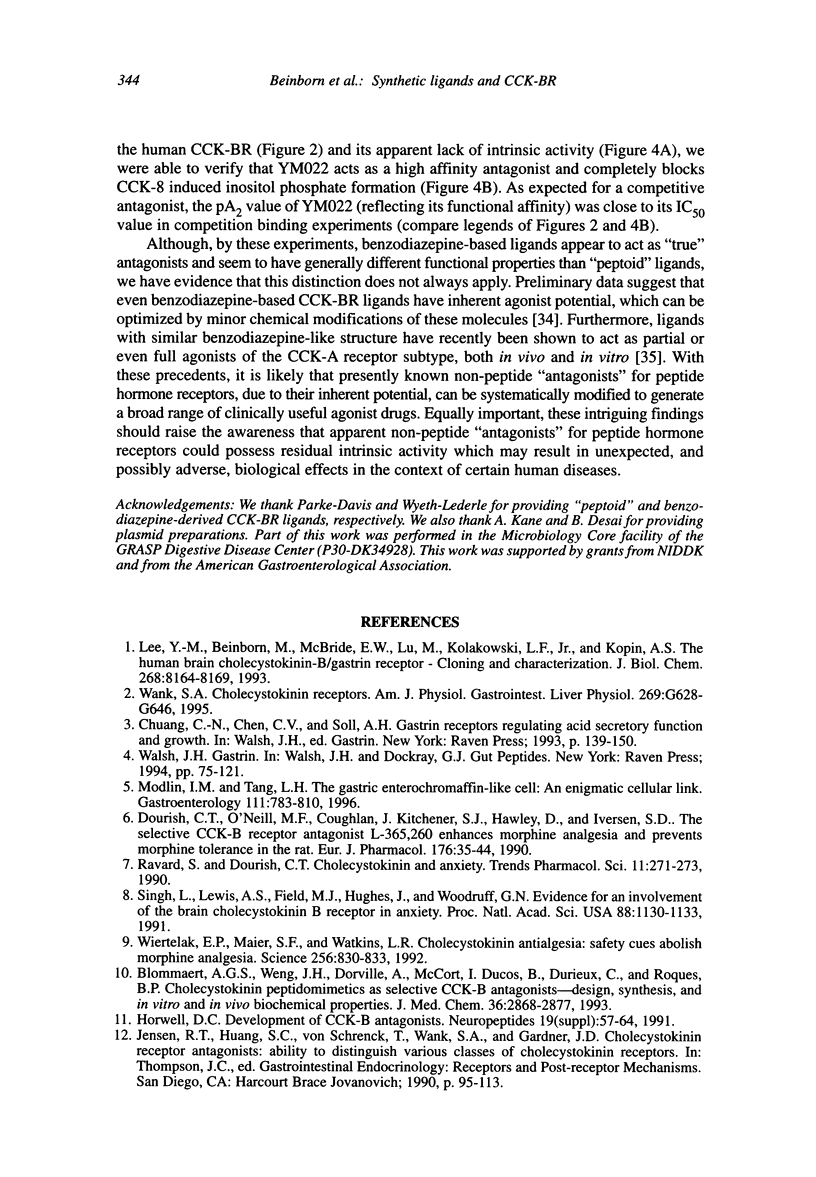


Selected References
These references are in PubMed. This may not be the complete list of references from this article.
- Blommaert A. G., Weng J. H., Dorville A., McCort I., Ducos B., Durieux C., Roques B. P. Cholecystokinin peptidomimetics as selective CCK-B antagonists: design, synthesis, and in vitro and in vivo biochemical properties. J Med Chem. 1993 Oct 1;36(20):2868–2877. doi: 10.1021/jm00072a005. [DOI] [PubMed] [Google Scholar]
- Boden P. R., Pinnock R. D., Pritchard M. C., Woodruff G. N. Evaluation of a series of novel CCKB antagonists using a functional assay in the rat central nervous system. Br J Pharmacol. 1994 Jun;112(2):666–670. doi: 10.1111/j.1476-5381.1994.tb13127.x. [DOI] [PMC free article] [PubMed] [Google Scholar]
- Chang R. S., Lotti V. J. Biochemical and pharmacological characterization of an extremely potent and selective nonpeptide cholecystokinin antagonist. Proc Natl Acad Sci U S A. 1986 Jul;83(13):4923–4926. doi: 10.1073/pnas.83.13.4923. [DOI] [PMC free article] [PubMed] [Google Scholar]
- Chew C. S., Brown M. R. Release of intracellular Ca2+ and elevation of inositol trisphosphate by secretagogues in parietal and chief cells isolated from rabbit gastric mucosa. Biochim Biophys Acta. 1986 Aug 29;888(1):116–125. doi: 10.1016/0167-4889(86)90077-7. [DOI] [PubMed] [Google Scholar]
- Ding X. Q., Chen D., Håkanson R. Cholecystokinin-B receptor ligands of the dipeptoid series act as agonists on rat stomach histidine decarboxylase. Gastroenterology. 1995 Oct;109(4):1181–1187. doi: 10.1016/0016-5085(95)90577-4. [DOI] [PubMed] [Google Scholar]
- Dourish C. T., O'Neill M. F., Coughlan J., Kitchener S. J., Hawley D., Iversen S. D. The selective CCK-B receptor antagonist L-365,260 enhances morphine analgesia and prevents morphine tolerance in the rat. Eur J Pharmacol. 1990 Jan 25;176(1):35–44. doi: 10.1016/0014-2999(90)90129-t. [DOI] [PubMed] [Google Scholar]
- Dunlop J., Brammer N., Ennis C. Pharmacological characterization of a Chinese hamster ovary cell line transfected with the human CCK-B receptor gene. Neuropeptides. 1996 Aug;30(4):359–363. doi: 10.1016/s0143-4179(96)90025-6. [DOI] [PubMed] [Google Scholar]
- Eissele R., Koop H., Bothe-Sandfort E., Arnold R. Effect of gastrin receptor antagonists on gastric acid secretion and gastrin and somatostatin release in the rat stomach. Digestion. 1992;53(3-4):179–188. doi: 10.1159/000200993. [DOI] [PubMed] [Google Scholar]
- Eissele R., Patberg H., Koop H., Krack W., Lorenz W., McKnight A. T., Arnold R. Effect of gastrin receptor blockade on endocrine cells in rats during achlorhydria. Gastroenterology. 1992 Nov;103(5):1596–1601. doi: 10.1016/0016-5085(92)91183-5. [DOI] [PubMed] [Google Scholar]
- Hayward N. J., Harding M., Lloyd S. A., McKnight A. T., Hughes J., Woodruff G. N. The effect of CCKB/gastrin antagonists on stimulated gastric acid secretion in the anaesthetized rat. Br J Pharmacol. 1991 Dec;104(4):973–977. doi: 10.1111/j.1476-5381.1991.tb12535.x. [DOI] [PMC free article] [PubMed] [Google Scholar]
- Hirst G. C., Aquino C., Birkemo L., Croom D. K., Dezube M., Dougherty R. W., Jr, Ervin G. N., Grizzle M. K., Henke B., James M. K. Discovery of 1,5-benzodiazepines with peripheral cholecystokinin (CCK-A) receptor agonist activity (II): Optimization of the C3 amino substituent. J Med Chem. 1996 Dec 20;39(26):5236–5245. doi: 10.1021/jm9601664. [DOI] [PubMed] [Google Scholar]
- Horwell D. C. Development of CCK-B antagonists. Neuropeptides. 1991 Jul;19 (Suppl):57–64. doi: 10.1016/0143-4179(91)90083-u. [DOI] [PubMed] [Google Scholar]
- Horwell D. C., Hughes J., Hunter J. C., Pritchard M. C., Richardson R. S., Roberts E., Woodruff G. N. Rationally designed "dipeptoid" analogues of CCK. alpha-Methyltryptophan derivatives as highly selective and orally active gastrin and CCK-B antagonists with potent anxiolytic properties. J Med Chem. 1991 Jan;34(1):404–414. doi: 10.1021/jm00105a062. [DOI] [PubMed] [Google Scholar]
- Hughes J., Boden P., Costall B., Domeney A., Kelly E., Horwell D. C., Hunter J. C., Pinnock R. D., Woodruff G. N. Development of a class of selective cholecystokinin type B receptor antagonists having potent anxiolytic activity. Proc Natl Acad Sci U S A. 1990 Sep;87(17):6728–6732. doi: 10.1073/pnas.87.17.6728. [DOI] [PMC free article] [PubMed] [Google Scholar]
- Kopin A. S., McBride E. W., Quinn S. M., Kolakowski L. F., Jr, Beinborn M. The role of the cholecystokinin-B/gastrin receptor transmembrane domains in determining affinity for subtype-selective ligands. J Biol Chem. 1995 Mar 10;270(10):5019–5023. doi: 10.1074/jbc.270.10.5019. [DOI] [PubMed] [Google Scholar]
- Lazareno S., Birdsall N. J. Estimation of antagonist Kb from inhibition curves in functional experiments: alternatives to the Cheng-Prusoff equation. Trends Pharmacol Sci. 1993 Jun;14(6):237–239. doi: 10.1016/0165-6147(93)90018-f. [DOI] [PubMed] [Google Scholar]
- Lee Y. M., Beinborn M., McBride E. W., Lu M., Kolakowski L. F., Jr, Kopin A. S. The human brain cholecystokinin-B/gastrin receptor. Cloning and characterization. J Biol Chem. 1993 Apr 15;268(11):8164–8169. [PubMed] [Google Scholar]
- Lotti V. J., Chang R. S. A new potent and selective non-peptide gastrin antagonist and brain cholecystokinin receptor (CCK-B) ligand: L-365,260. Eur J Pharmacol. 1989 Mar 21;162(2):273–280. doi: 10.1016/0014-2999(89)90290-2. [DOI] [PubMed] [Google Scholar]
- Modlin I. M., Tang L. H. The gastric enterochromaffin-like cell: an enigmatic cellular link. Gastroenterology. 1996 Sep;111(3):783–810. doi: 10.1053/gast.1996.v111.agast961110783. [DOI] [PubMed] [Google Scholar]
- Muallem S., Sachs G. Changes in cytosolic free Ca2+ in isolated parietal cells. Differential effects of secretagogues. Biochim Biophys Acta. 1984 Oct 12;805(2):181–185. doi: 10.1016/0167-4889(84)90166-6. [DOI] [PubMed] [Google Scholar]
- Nishida A., Miyata K., Tsutsumi R., Yuki H., Akuzawa S., Kobayashi A., Kamato T., Ito H., Yamano M., Katuyama Y. Pharmacological profile of (R)-1-[2,3-dihydro-1-(2'-methylphenacyl)-2-oxo- 5-phenyl-1H-1,4-benzodiazepin-3-yl]-3-(3-methylphenyl)urea (YM022), a new potent and selective gastrin/cholecystokinin-B receptor antagonist, in vitro and in vivo. J Pharmacol Exp Ther. 1994 May;269(2):725–731. [PubMed] [Google Scholar]
- Rajan A. S., Hill R. S., Boyd A. E., 3rd Effect of rise in cAMP levels on Ca2+ influx through voltage-dependent Ca2+ channels in HIT cells. Second-messenger synarchy in beta-cells. Diabetes. 1989 Jul;38(7):874–880. doi: 10.2337/diab.38.7.874. [DOI] [PubMed] [Google Scholar]
- Ravard S., Dourish C. T. Cholecystokinin and anxiety. Trends Pharmacol Sci. 1990 Jul;11(7):271–273. doi: 10.1016/0165-6147(90)90004-r. [DOI] [PubMed] [Google Scholar]
- Roche S., Bali J. P., Magous R. Involvement of a pertussis toxin-sensitive G protein in the action of gastrin on gastric parietal cells. Biochim Biophys Acta. 1990 Dec 10;1055(3):287–294. doi: 10.1016/0167-4889(90)90045-f. [DOI] [PubMed] [Google Scholar]
- Schmassmann A., Garner A., Flogerzi B., Hasan M. Y., Sanner M., Varga L., Halter F. Cholecystokinin type B receptor antagonist PD-136,450 is a partial secretory agonist in the stomach and a full agonist in the pancreas of the rat. Gut. 1994 Feb;35(2):270–274. doi: 10.1136/gut.35.2.270. [DOI] [PMC free article] [PubMed] [Google Scholar]
- Seidler U., Pfeiffer A. Inositol phosphate formation and [Ca2+]i in secretagogue-stimulated rabbit gastric mucous cells. Am J Physiol. 1991 Jan;260(1 Pt 1):G133–G141. doi: 10.1152/ajpgi.1991.260.1.G133. [DOI] [PubMed] [Google Scholar]
- Singh L., Lewis A. S., Field M. J., Hughes J., Woodruff G. N. Evidence for an involvement of the brain cholecystokinin B receptor in anxiety. Proc Natl Acad Sci U S A. 1991 Feb 15;88(4):1130–1133. doi: 10.1073/pnas.88.4.1130. [DOI] [PMC free article] [PubMed] [Google Scholar]
- Wank S. A. Cholecystokinin receptors. Am J Physiol. 1995 Nov;269(5 Pt 1):G628–G646. doi: 10.1152/ajpgi.1995.269.5.G628. [DOI] [PubMed] [Google Scholar]
- Wettstein J. G., Buéno L., Junien J. L. CCK antagonists: pharmacology and therapeutic interest. Pharmacol Ther. 1994;62(3):267–282. doi: 10.1016/0163-7258(94)90047-7. [DOI] [PubMed] [Google Scholar]
- Wiertelak E. P., Maier S. F., Watkins L. R. Cholecystokinin antianalgesia: safety cues abolish morphine analgesia. Science. 1992 May 8;256(5058):830–833. doi: 10.1126/science.1589765. [DOI] [PubMed] [Google Scholar]


